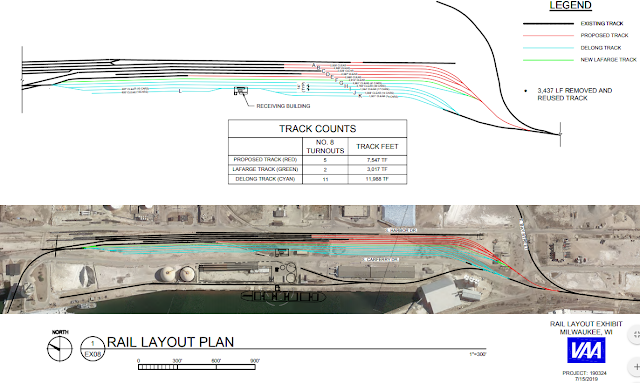 |
| Korey Garceau posted Le Bellot moored at the City Heavy Lift Dock at Port Milwaukee this afternoon. This was her last visit of the season, and she will soon be departing on her outbound trip from the Great Lakes. 10/9/23 Steve Horton: The best place Milwaukee could find to dock a cruise ship was next to the sewage treatment plant?? Korey Garceau: Steve Horton This vessel usually calls on the Pier Wisconsin dock. This is the only inner harbor facility that can accommodate the necessary shoreside services. [I'd like the scenery here, but I don't think most passengers would like it. I hope the water reclamation plant doesn't smell.] |
The ethanol fuel industry was evidently built on a federal regulation requiring that ethanol be added to gasoline. As the Trump administration is relaxing that regulation, the price of ethanol is going down. A new plant based on a new technology to convert cellulosic waste (e.g. corn stalks) has already shut down. Traditionally, distiller grains were a waste byproduct of producing ethanol. It is basically those part of the corn kernel that the yeast could not eat. That is, it is the corn kernel without the sugars. DDGS are high in protein so the ethanol plants would dry them and sell them to help make animal feed. In fact, some plants ship the waste while it is still wet because they can quickly get it to a feedlot.
DDGS has become valuable enough that Green Plains Inc plans to spend $400m to convert its 13 plants to make high-protein animal feeds and marketing the ethanol as the waste product. Another driving economic factor is that "global demand for meat is surging as the deadly African swine fever culls herds in China, Southeast Asia and parts of Europe." Normal DDGS is 30% protein. Green Plains plans to enhance their plants to use enzymes and microbial technologies developed by Novozymes A/S to boost the protein to 50-60%. Even at just 50%, it has more protein than soymeal, which sells for about double the price of DDGS. The initial market is expected to be fish farms and pet food companies. [reuters]
In addition to shipping meat to foreign countries, some ethanol plants plan to export DDGS. The Port of Milwaukee is spending $31m to build an agriculture products export facility on the west side of Jones Island. $16m is federal money granted by the U.S. Department of Transportation. DDGS is explicitly mentioned as one of the products to be exported in Seawaymax ships. [jsonline]
 |
| PortMilwaukee |
The DeLong Co., Inc. intends to lease a parcel of property at Port Milwaukee's Jones Island facility. As a PIDP grantee, Port Milwaukee will develop an agricultural commodity transload facility for bulk shipments in Milwaukee's inner harbor. This facility is expected to be the first on the Great Lakes - St. Lawrence Seaway (GLSLS) system specifically for the transload and export of Dry Distillers Grain with Solubles (DDGs). Supplemental service is also envisioned for the export of soybeans, corn and grain via deep-draft, Seawaymax vessels. [PortMilwaukee-AgExport]
 |
| DesignPlans |
 |
| WISN (source) Less than a month after Port Milwaukee sustained flood damage, it's getting $31 million for new improvements. The U.S. Army Corps of Engineers said Lake Michigan was at the highest it has ever been in the month of January. More than $15 million of the funding was awarded by the U.S. Department of Transportation's $280 million infrastructure plan. |
Hi,
ReplyDeleteThanks for sharing article such as so amazing and attractive, then i refer other people and friends.
Thanks for this blog information so useful.
ReplyDeleteMahindra tractor